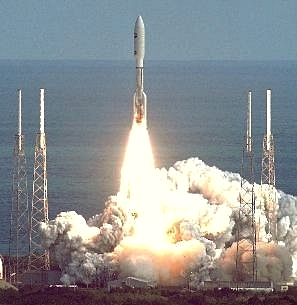
 NASA's New Horizons Launching to Pluto. This is NASA's New Horizons mission launching to Pluto, January 19th, 2006, 2 p.m. EST (19h GMT) from the Cape Canaveral Air Force Station (CCAFS), pad 41 at the Kennedy Space Center, Fl. New Horizons is a mission to Pluto, the farthest planet in our solar system and the sole which was never visited ever since the beginning of the space age. Pluto is taking 248 years to complete its orbit, as it was discovered in 1930 by Clyde W. Tombaugh at the Lowell Observatory, Flagstaff, Az. The mission is seen here launching atop the Lockheed Martin Atlas V rocket, a powerful launcher helped by five strap-on boosters. The fairing, this whitemost, top part of the rocket is harboring the Centaur upper stage, the Boeing STAR-48B solid-propellant rocket third stage, and the spacecraft proper, affixed to the latter. New Horizons is the fastest spacecraft launched ever. It reached the lunar orbit 9 hours after launch only, as it will be at Jupiter in 13 months only! Despite such a speed, the arrival at Pluto will not occur before July 2015. The spacecraft will use a gravity-assisted flyby at Jupiter, this technique which allows to take advantage -both in momentum and direction, of the gravitational tug of a planet. The New Horizons mission will shed light on Pluto's (and its moon Charon's) surface properties, geology, interior and atmospheres. Should NASA extend the mission, the spacecraft would continue into the Kuiper Belt, this disk of leftovers of the solar system formation, targeting two or more objects there, within two to three years of the flyby at Pluto, of the size of 30 miles (50 km) in diameter. New Horizons has been designed and built at the Johns Hopkins University Applied Physics Laboratory, Laurel, Md. picture NASA/KSC
NASA's New Horizons Launching to Pluto. This is NASA's New Horizons mission launching to Pluto, January 19th, 2006, 2 p.m. EST (19h GMT) from the Cape Canaveral Air Force Station (CCAFS), pad 41 at the Kennedy Space Center, Fl. New Horizons is a mission to Pluto, the farthest planet in our solar system and the sole which was never visited ever since the beginning of the space age. Pluto is taking 248 years to complete its orbit, as it was discovered in 1930 by Clyde W. Tombaugh at the Lowell Observatory, Flagstaff, Az. The mission is seen here launching atop the Lockheed Martin Atlas V rocket, a powerful launcher helped by five strap-on boosters. The fairing, this whitemost, top part of the rocket is harboring the Centaur upper stage, the Boeing STAR-48B solid-propellant rocket third stage, and the spacecraft proper, affixed to the latter. New Horizons is the fastest spacecraft launched ever. It reached the lunar orbit 9 hours after launch only, as it will be at Jupiter in 13 months only! Despite such a speed, the arrival at Pluto will not occur before July 2015. The spacecraft will use a gravity-assisted flyby at Jupiter, this technique which allows to take advantage -both in momentum and direction, of the gravitational tug of a planet. The New Horizons mission will shed light on Pluto's (and its moon Charon's) surface properties, geology, interior and atmospheres. Should NASA extend the mission, the spacecraft would continue into the Kuiper Belt, this disk of leftovers of the solar system formation, targeting two or more objects there, within two to three years of the flyby at Pluto, of the size of 30 miles (50 km) in diameter. New Horizons has been designed and built at the Johns Hopkins University Applied Physics Laboratory, Laurel, Md. picture NASA/KSC
 Image choisie: La mission New Horizons décolle pour Pluton
Image choisie: La mission New Horizons décolle pour Pluton
La mission New Horizons, de la NASA, est vue ici au décollage. La fusée s'élève au-dessus du pas de tir 41 de la "Cape Canaveral Air Force Station", cette zone du complexe Cap Kennedy qui sert aux lancements autres que ceux de la navette spatiale. Le lancement a eu lieu le 19 janvier à 19h GMT. New Horizons est une mission à destination de Pluton, la plus lointaine des planètes du système solaire. Pluton n'a jamais fait, jusque là, l'objet d'une mission spatiale. La planète lointaine n'a été découverte qu'en 1930 par Clyde W. Tombaugh. La mission utilise comme lanceur une puissante Atlas V à laquelle sont fixées cinq fusées d'appoint à carburant solide. La partie aérodynamique de la fusée abrite le second étage, un Centaur, le troisième étage, un Boeing STAR-48B et la mission même. La vitesse de New Horizons, au long de sa trajectoire, est la plus rapide jamais atteinte par une sonde interplanétaire: la mission a atteint l'orbite lunaire en 9 heures et elle sera à Jupiter en 13 mois! Et malgré cela, il lui faudra 9 ans pour atteindre Pluton. La mission utilisera un passage assisté par gravité à Jupiter, cette technique qui permet, à la fois en vitesse et en direction, de prendre avantage de l'effet gravitationnel d'une planète. New Horizons permettra de mieux connaître Pluton et sa lune Charon. Et, si la NASA étend la mission, la sonde continuera son voyage dans la Kuiper Belt, ce disque de restes de la formation du système solaire qui s'étend au-delà de l'orbite de Pluton. Là dans les deux à trois ans qui suivent, elle devrait visiter deux objets, ou plus. La mission New Horizons a été conçue et construite par le Johns Hopkins University Applied Physics Laboratory, à Laurel, dans le Maryland. image NASA/KSC
Website Manager: G. Guichard, site 'Amateur Astronomy,' http://stars5.6te.net. Page Editor: G. Guichard. last edited: 12/28/2010. contact us at ggwebsites@outlook.com


![]() Image choisie: La mission New Horizons décolle pour Pluton
Image choisie: La mission New Horizons décolle pour Pluton